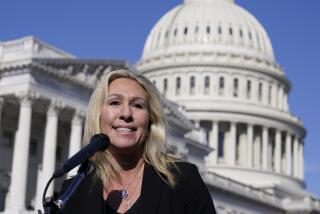Stubborn Debt Burden Spurs Search for New Ideas
- Share via
WASHINGTON — Eight years after the world’s wealthiest nations agreed to reduce the debts of the poorest, some developing countries are still struggling to stay afloat and promised relief has been slower than expected in coming.
The limited success of past debt relief initiatives is expected to weigh on finance ministers as they gather in Washington this weekend for spring meetings of the International Monetary Fund and World Bank.
Debt relief advocates are pressing wealthy governments to not only make good on past commitments but to also expand relief so poor countries can spend more on AIDS treatment and other health, education and poverty-reduction programs.
Some activists say the time has come to forgive the debt entirely.
“After eight years, we see a lot of failures,” said Marie Clarke, national coordinator for Jubilee USA Network, a debt relief coalition. “This is the time. They’ve had their chance. We’re calling for full debt cancellation.”
Their appeal has been bolstered by critical assessments of the Heavily Indebted Poor Countries initiative launched by the IMF and World Bank in 1996, including a recent congressional study projecting huge funding shortfalls in the years ahead.
Many officials and even some activists quarrel with the notion of complete debt cancellation, saying it would divert resources from other poor countries and reduce incentives for borrowers to clean up their finances. Yet even some big creditors say more should be done to lighten the developing world’s debt load.
U.S. Treasury Undersecretary John Taylor said Wednesday that the United States had agreed to write off 100% of the loans it has made directly to nations qualifying for HIPC relief, and was encouraging other big bilateral lenders to do the same.
In the future, Taylor said, wealthy nations should provide more assistance to poor countries in the form of grants, rather than making new loans that perpetuate the cycle of indebtedness. “We shouldn’t be providing new loans which we know are going to be forgiven in a very short period of time,” Taylor said.
Third World debt is one of the central issues to be addressed by several hundred delegates who will attend the closed-door sessions of the IMF and World Bank, as well as several thousand anti-globalization activists who are expected to rally in the streets outside.
Advocacy groups are also pressuring the international financial institutions to restrict future funding of big oil, gas and mining ventures, citing evidence that such projects rarely alleviate poverty and often foster corruption and oppression.
The debate over debt relief reflects what some experts consider one of the biggest obstacles to improving living conditions in the Third World, particularly in the impoverished nations of sub-Saharan Africa.
Some poor countries say they have been forced to shortchange health, education and other pressing development needs so they can keep making loan payments to the IMF, World Bank and other international lenders.
In 1996, the IMF and World Bank responded to growing pressure to relieve the debt crisis by launching the Heavily Indebted Poor Countries initiative. HIPC promised to reduce debt service requirements to more sustainable levels if poor countries pursued sound fiscal policies and adopted poverty reduction strategies.
However, even the World Bank has acknowledged in a recent assessment of the program’s progress that it has taken longer to bring debt relief than expected.
Of 38 countries considered in greatest need of relief, 27 qualified for a total of about $50 billion in debt write-downs. So far, 13 have successfully completed the program. The latest graduates, announced with considerable fanfare in recent days, are Ethiopia, which received $3.3 billion in relief; Senegal, which received $850 million; and Niger, which got $1.2 billion.
The 27 participating countries will reduce their total debt loads by two-thirds by the time they complete the HIPC process, World Bank officials say. Already, their payments have been cut by about a third, or $1.3 billion a year.
But they are not debt-free. Collins Magalasi, coordinator of the Economic Justice Network in Malawi, one of the world’s poorest nations, said 21% of government revenue was still devoted to debt payments, even after HIPC relief. That is about as much as Malawi spends on education, health, science and technology combined, he said.
“I don’t see how a country like mine will ever get out of this vicious cycle unless we have deeper debt relief,” he said.
According to a report issued last week by Congress’ General Accounting Office, HIPC faces a funding shortfall of $7.8 billion. That is how much the United States and other advanced countries would need to contribute to the World Bank and other multilateral lenders to provide relief under the program’s current terms.
Even if they make good on their pledges, an additional $8.5 billion to $19.8 billion may be needed over the next 16 years to reduce debt burdens to truly sustainable levels, GAO auditors said.
Additionally, those amounts are dwarfed by the future cost of helping poor countries achieve the economic growth and poverty reduction targets set under the United Nations Millennium Development Goals. That initiative envisions universal primary education in poor nations and halving the number of people who suffer hunger and extreme poverty by 2015.
To reach all the development goals by 2020, poor countries would need to receive $153 billion in development assistance already proposed by the IMF and World Bank plus $215 billion to make up for overly optimistic assumptions in the two institutions’ official projections, the GAO report said.
“HIPC certainly has been quite useful, but it has not been enough,” said Finance Minister Yaw Osafo-Maafo of Ghana, whose country is considered one of the program’s success stories. “If it is to create a platform for long-term debt sustainability, it has a long way to go.”
More to Read
Sign up for Essential California
The most important California stories and recommendations in your inbox every morning.
You may occasionally receive promotional content from the Los Angeles Times.










